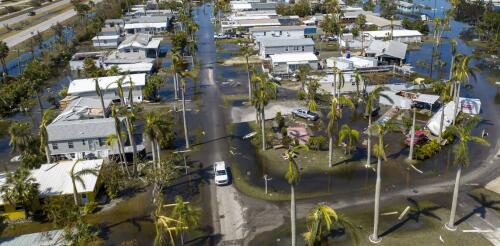Climate change
Millions of Americans have been watching with growing alarm as their homeowners insurance premiums rise and their coverage shrinks. Nationwide, premiums rose 34% between 2017 and 2023, and they continued to rise in 2024 across much of the country. To add insult to injury, those rates go even higher if you make a claim – as much as 25% if you claim a total loss of your home. Why is this happening? There are a few reasons, but a common thread: Climate change is fueling more severe weather, and insurers are responding to rising damage claims. The losses are exacerbated by more frequent extreme weather disasters striking densely populated areas, rising construction costs and homeowners experiencing damage that was once more rare. Hurricane Ian, supercharged by warm water in the Gulf of Mexico, hit Florida as a Category 4 hurricane in October 2022 and caused an estimated $112.9 billion in damage. Ricardo Arduengo/AFP via...
As a child growing up in the early 1990s, I remember learning in school about the greenhouse effect. Carbon dioxide released by burning fossil fuels traps heat near the Earth’s surface, like the glass of a greenhouse. I imagined myself on the playground, roasting inside a humid hothouse. Fast forward 30 years, and the terms have changed. For a while, “global warming” was the go-to expression for talking about rising global temperatures and the role of human activities, particularly the use of fossil fuels. It had a spike in internet searches in 2007, probably due to former Vice President Al Gore’s documentary “An Inconvenient Truth: A Global Warning,” which hit theaters in 2006. Near the end of the Obama administration, “climate change” became the most common term. It’s now trending in Google searches more than global warming. Both terms make the same point: Rising global temperatures have major consequences on local weather...
Imperial County consistently ranks among the most economically distressed places in California. Its Salton Sea, the state’s biggest and most toxic lake, is an environmental disaster. And the region’s politics have been dominated by a conservative white elite, despite its supermajority Latino population. The county also happens to be sitting on enough lithium to produce nearly 400 million batteries, sufficient to completely revamp the American auto fleet to electric propulsion. Even better, that lithium could be extracted in a way consistent with broader goals to reduce pollution. The traditional ways to extract lithium involve either hard rock mining, which generates lots of waste, or large evaporation ponds, which waste a lot of water. In Imperial Valley, companies are pioneering a third method. They are extracting the mineral from the underground briny water brought up during geothermal energy production and then injecting that briny water back into the ground in a...
Warm water in the Atlantic Ocean and Gulf of Mexico can fuel powerful hurricanes, but how destructive a storm becomes isn’t just about the climate and weather – it also depends on the people and property in harm’s way. In many coastal cities, fast population growth has left more people living in areas at high risk of flooding. I am a geographer who studies the human dimensions of climate change and natural disasters. My research and mapping with colleagues shows that socially vulnerable communities – those least able to prepare for disasters or recover afterward – tend to be concentrated in areas that are more susceptible to flooding, particularly on the Gulf Coast. Larger, vulnerable populations Nearly 40% of the U.S. population lives in a coastal county today. Many of these areas are increasingly exposed to disasters, including hurricanes and high tide flooding that has been worsened by sea level rise. The Gulf of Mexico region, in particular,...
Summer 2024 was officially the Northern Hemisphere’s hottest on record. In the United States, fierce heat waves seemed to hit somewhere almost every day. Phoenix reached 100 degrees for more than 100 days straight. The 2024 Olympic Games started in the midst of a long-running heat wave in Europe that included the three hottest days on record globally, July 21-23. August was Earth’s hottest month in the National Oceanic and Atmospheric Administration’s 175-year record. Overall, the global average temperature was 2.74 degrees Fahrenheit (1.52 degrees Celsius) above the 20th-century average. That might seem small, but temperature increases associated with human-induced climate change do not manifest as small, even increases everywhere on the planet. Rather, they result in more frequent and severe episodes of heat waves, as the world saw in 2024. The most severe and persistent heat waves are often associated with an atmospheric pattern called a heat dome. As a...




